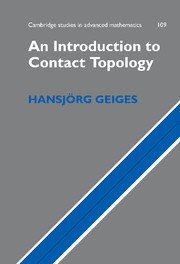Book contents
- Frontmatter
- Contents
- Preface
- 1 Facets of contact geometry
- 2 Contact manifolds
- 3 Knots in contact 3—manifolds
- 4 Contact structures on 3—manifolds
- 5 Symplectic fillings and convexity
- 6 Contact surgery
- 7 Further constructions of contact manifolds
- 8 Contact structures on 5—manifolds
- Appendix A The generalised Poincaré lemma
- Appendix B Time-dependent vector fields
- References
- Notation index
- Author index
- Subject index
3 - Knots in contact 3—manifolds
Published online by Cambridge University Press: 05 November 2009
- Frontmatter
- Contents
- Preface
- 1 Facets of contact geometry
- 2 Contact manifolds
- 3 Knots in contact 3—manifolds
- 4 Contact structures on 3—manifolds
- 5 Symplectic fillings and convexity
- 6 Contact surgery
- 7 Further constructions of contact manifolds
- 8 Contact structures on 5—manifolds
- Appendix A The generalised Poincaré lemma
- Appendix B Time-dependent vector fields
- References
- Notation index
- Author index
- Subject index
Summary
‘Quem faz nós, quem os desata’
José Saramago, Fado AdivinhaThe study of knots in 3—manifolds is a venerable subject in its own right, the main question being the classification of knots in 3—space up to isotopy. But knots also play an important supporting role in the geometric topology of 3—manifolds, for instance via the surgery construction discussed in Chapter 1.
When we turn to contact 3—manifolds, the situation is analogous. Here there are two distinguished classes of knots: the Legendrian and the transverse ones. Again, these are interesting objects in their own right, and much can be said about the classification of these knots (up to isotopy through knots of the given type). A comprehensive survey about these matters is given by Etnyre [82].
In the present chapter I shall concentrate on those aspects of the theory of Legendrian and transverse knots that are relevant for the construction and classification of contact 3—manifolds via surgical constructions along such knots.
Section 3.1 contains the basic definitions. In Section 3.2 we discuss how Legendrian and transverse knots can be visualised by two kinds of 2—dimensional projections adapted to the contact structure, viz., the front and the Lagrangian projection. These will be used in Section 3.3 for proving that every knot can be approximated both by a Legendrian or by a transverse knot in the same topological isotopy class.
- Type
- Chapter
- Information
- An Introduction to Contact Topology , pp. 93 - 129Publisher: Cambridge University PressPrint publication year: 2008

